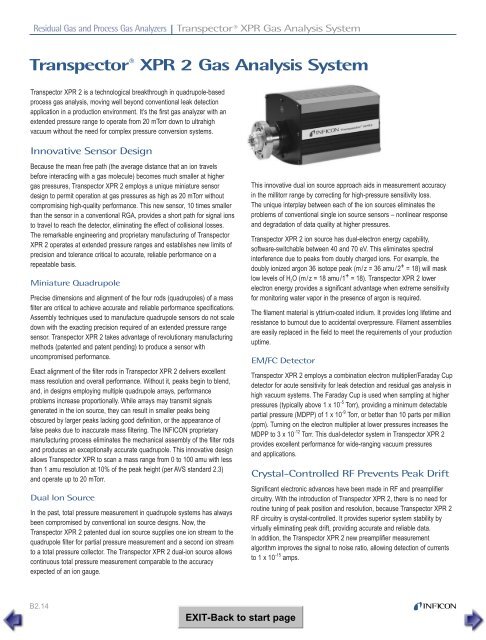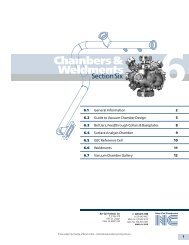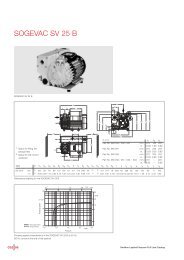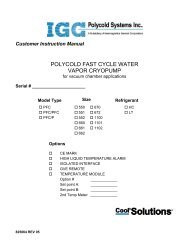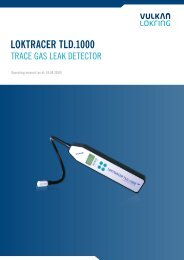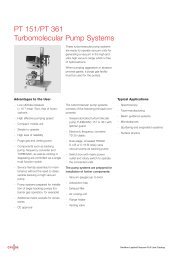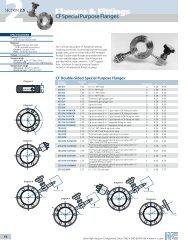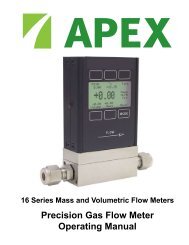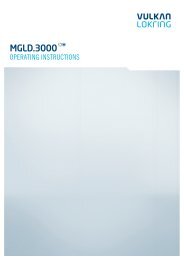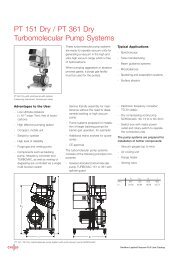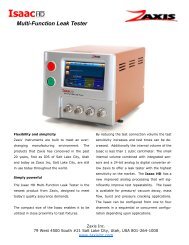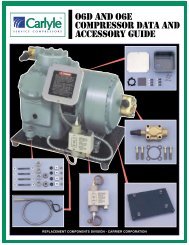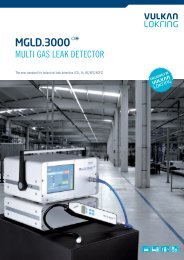B2 - Schoonover, Inc.
B2 - Schoonover, Inc.
B2 - Schoonover, Inc.
Create successful ePaper yourself
Turn your PDF publications into a flip-book with our unique Google optimized e-Paper software.
Residual Gas and Process Gas Analyzers<br />
Transpector® XPR Gas Analysis System<br />
Transpector ® XPR 2 Gas Analysis System<br />
Transpector XPR 2 is a technological breakthrough in quadrupole-based<br />
process gas analysis, moving well beyond conventional leak detection<br />
application in a production environment. ItÕs the first gas analyzer with an<br />
extended pressure range to operate from 20 mTorr down to ultrahigh<br />
vacuum without the need for complex pressure conversion systems.<br />
Innovative Sensor Design<br />
Because the mean free path (the average distance that an ion travels<br />
before interacting with a gas molecule) becomes much smaller at higher<br />
gas pressures, Transpector XPR 2 employs a unique miniature sensor<br />
design to permit operation at gas pressures as high as 20 mTorr without<br />
compromising high-quality performance. This new sensor, 10 times smaller<br />
than the sensor in a conventional RGA, provides a short path for signal ions<br />
to travel to reach the detector, eliminating the effect of collisional losses.<br />
The remarkable engineering and proprietary manufacturing of Transpector<br />
XPR 2 operates at extended pressure ranges and establishes new limits of<br />
precision and tolerance critical to accurate, reliable performance on a<br />
repeatable basis.<br />
Miniature Quadrupole<br />
Precise dimensions and alignment of the four rods (quadrupoles) of a mass<br />
filter are critical to achieve accurate and reliable performance specifications.<br />
Assembly techniques used to manufacture quadrupole sensors do not scale<br />
down with the exacting precision required of an extended pressure range<br />
sensor. Transpector XPR 2 takes advantage of revolutionary manufacturing<br />
methods (patented and patent pending) to produce a sensor with<br />
uncompromised performance.<br />
Exact alignment of the filter rods in Transpector XPR 2 delivers excellent<br />
mass resolution and overall performance. Without it, peaks begin to blend,<br />
and, in designs employing multiple quadrupole arrays, performance<br />
problems increase proportionally. While arrays may transmit signals<br />
generated in the ion source, they can result in smaller peaks being<br />
obscured by larger peaks lacking good definition, or the appearance of<br />
false peaks due to inaccurate mass filtering. The INFICON proprietary<br />
manufacturing process eliminates the mechanical assembly of the filter rods<br />
and produces an exceptionally accurate quadrupole. This innovative design<br />
allows Transpector XPR to scan a mass range from 0 to 100 amu with less<br />
than 1 amu resolution at 10% of the peak height (per AVS standard 2.3)<br />
and operate up to 20 mTorr.<br />
Dual lon Source<br />
In the past, total pressure measurement in quadrupole systems has always<br />
been compromised by conventional ion source designs. Now, the<br />
Transpector XPR 2 patented dual ion source supplies one ion stream to the<br />
quadrupole filter for partial pressure measurement and a second ion stream<br />
to a total pressure collector. The Transpector XPR 2 dual-ion source allows<br />
continuous total pressure measurement comparable to the accuracy<br />
expected of an ion gauge.<br />
This innovative dual ion source approach aids in measurement accuracy<br />
in the millitorr range by correcting for high-pressure sensitivity loss.<br />
The unique interplay between each of the ion sources eliminates the<br />
problems of conventional single ion source sensors Ð nonlinear response<br />
and degradation of data quality at higher pressures.<br />
Transpector XPR 2 ion source has dual-electron energy capability,<br />
software-switchable between 40 and 70 eV. This eliminates spectral<br />
interference due to peaks from doubly charged ions. For example, the<br />
doubly ionized argon 36 isotope peak (m/z = 36 amu/2 + = 18) will mask<br />
low levels of H 2 O (m/z = 18 amu/1 + = 18). Transpector XPR 2 lower<br />
electron energy provides a significant advantage when extreme sensitivity<br />
for monitoring water vapor in the presence of argon is required.<br />
The filament material is yttrium-coated iridium. It provides long lifetime and<br />
resistance to burnout due to accidental overpressure. Filament assemblies<br />
are easily replaced in the field to meet the requirements of your production<br />
uptime.<br />
EM/FC Detector<br />
Transpector XPR 2 employs a combination electron multiplier/Faraday Cup<br />
detector for acute sensitivity for leak detection and residual gas analysis in<br />
high vacuum systems. The Faraday Cup is used when sampling at higher<br />
pressures (typically above 1 x 10 -5 Torr), providing a minimum detectable<br />
partial pressure (MDPP) of 1 x 10 -9 Torr, or better than 10 parts per million<br />
(ppm). Turning on the electron multiplier at lower pressures increases the<br />
MDPP to 3 x 10 -12 Torr. This dual-detector system in Transpector XPR 2<br />
provides excellent performance for wide-ranging vacuum pressures<br />
and applications.<br />
Crystal-Controlled RF Prevents Peak Drift<br />
Significant electronic advances have been made in RF and preamplifier<br />
circuitry. With the introduction of Transpector XPR 2, there is no need for<br />
routine tuning of peak position and resolution, because Transpector XPR 2<br />
RF circuitry is crystal-controlled. It provides superior system stability by<br />
virtually eliminating peak drift, providing accurate and reliable data.<br />
In addition, the Transpector XPR 2 new preamplifier measurement<br />
algorithm improves the signal to noise ratio, allowing detection of currents<br />
to 1 x 10 -15 amps.<br />
<strong>B2</strong>.14


